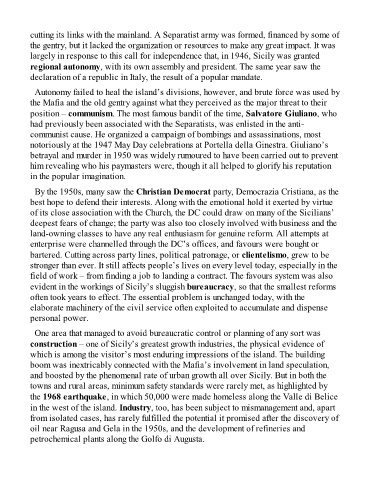Page 573 - The Rough Guide of Sicily
P. 573
cutting its links with the mainland. A Separatist army was formed, financed by some of
the gentry, but it lacked the organization or resources to make any great impact. It was
largely in response to this call for independence that, in 1946, Sicily was granted
regional autonomy, with its own assembly and president. The same year saw the
declaration of a republic in Italy, the result of a popular mandate.
Autonomy failed to heal the island’s divisions, however, and brute force was used by
the Mafia and the old gentry against what they perceived as the major threat to their
position – communism. The most famous bandit of the time, Salvatore Giuliano, who
had previously been associated with the Separatists, was enlisted in the anti-
communist cause. He organized a campaign of bombings and assassinations, most
notoriously at the 1947 May Day celebrations at Portella della Ginestra. Giuliano’s
betrayal and murder in 1950 was widely rumoured to have been carried out to prevent
him revealing who his paymasters were, though it all helped to glorify his reputation
in the popular imagination.
By the 1950s, many saw the Christian Democrat party, Democrazia Cristiana, as the
best hope to defend their interests. Along with the emotional hold it exerted by virtue
of its close association with the Church, the DC could draw on many of the Sicilians’
deepest fears of change; the party was also too closely involved with business and the
land-owning classes to have any real enthusiasm for genuine reform. All attempts at
enterprise were channelled through the DC’s offices, and favours were bought or
bartered. Cutting across party lines, political patronage, or clientelismo, grew to be
stronger than ever. It still affects people’s lives on every level today, especially in the
field of work – from finding a job to landing a contract. The favours system was also
evident in the workings of Sicily’s sluggish bureaucracy, so that the smallest reforms
often took years to effect. The essential problem is unchanged today, with the
elaborate machinery of the civil service often exploited to accumulate and dispense
personal power.
One area that managed to avoid bureaucratic control or planning of any sort was
construction – one of Sicily’s greatest growth industries, the physical evidence of
which is among the visitor’s most enduring impressions of the island. The building
boom was inextricably connected with the Mafia’s involvement in land speculation,
and boosted by the phenomenal rate of urban growth all over Sicily. But in both the
towns and rural areas, minimum safety standards were rarely met, as highlighted by
the 1968 earthquake, in which 50,000 were made homeless along the Valle di Belice
in the west of the island. Industry, too, has been subject to mismanagement and, apart
from isolated cases, has rarely fulfilled the potential it promised after the discovery of
oil near Ragusa and Gela in the 1950s, and the development of refineries and
petrochemical plants along the Golfo di Augusta.

